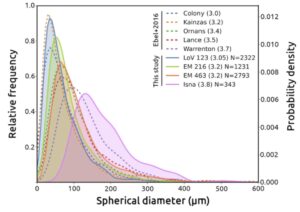Pinto, G.A. ; Marrocchi, Y. ; Morbidelli, A. ; Charnoz, S. ; Varela, M.E. ; Soto, K. ; Martinez, R. ; Olivares, F. (2021) The Astrophysical Journal Letters, 917, L25
Voir en ligne : https://doi.org/10.3847/2041-8213/ac17f2

Abstract :
The formation of planetesimals was a key step in the assemblage of planetary bodies, yet many aspects of their formation remain poorly constrained. Notably, the mechanism by which chondrules—submillimetric spheroids that dominate primitive meteorites—were incorporated into planetesimals remains poorly understood. Here we classify and analyze particle-size distributions in various CO carbonaceous chondrites found in the Atacama Desert. Our results show that the average circle-equivalent diameters of chondrules define a positive trend with the petrographic grade, which reflects the progressive role of thermal metamorphism within the CO parent body. We show that this relationship could not have been established by thermal metamorphism alone but rather by aerodynamic sorting during accretion. By modeling the self-gravitational contraction of clumps of chondrules, we show that (i) the accretion of the CO parent body(ies) would have generated a gradual change of chondrule size with depth in the parent body, with larger chondrules being more centrally concentrated than smaller ones, and (ii) any subsequent growth by pebble accretion would have been insignificant. These findings give substantial support to the view that planetesimals formed via gravitational collapse.



